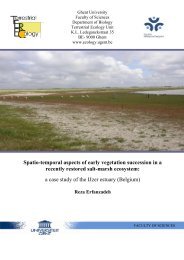PhD Arthur Decae 2010 - Ghent Ecology - Universiteit Gent
PhD Arthur Decae 2010 - Ghent Ecology - Universiteit Gent
PhD Arthur Decae 2010 - Ghent Ecology - Universiteit Gent
You also want an ePaper? Increase the reach of your titles
YUMPU automatically turns print PDFs into web optimized ePapers that Google loves.
Figs 79-82 Trapdoors of Majorcan Nemesia species. 79 N. brauni; 80 N. bristowei, 81 N. seldeni;<br />
82 N. randa.<br />
46, 60 and 67. In the central areas of the distribution range, species with these two different<br />
types of spermathecae overlap. Nemesia carminans, which occurs in an area between the river<br />
Rhone in south-central France and the city of Genoa in northern Italy, is currently the species<br />
with "western-type" spermathecae that extend its distribution range furthest to the east.<br />
Nemesia dubia, with a distribution range between Montpellier (southern France) and eastern<br />
Spain (Blasco 1986b), is currently the most westward extending species with "eastern- type"<br />
spermathecae 17 . It is currently unknown if a similar phenomenon occurs on the north African<br />
side of the Mediterranean, but on Mediterranean islands it is evident from what is reported<br />
here, that of the seven Balearic species recognized six have "western-type" spermathecae and<br />
only N. seldeni has "eastern-type" spermathecae.<br />
Interspecific relationships of N. seldeni: Nemesia seldeni appears to belong to a tribe of small<br />
(♀ BL = 13-17 mm), wafer-door building Nemesia species that is here designated the<br />
maculatipes-group. Typical, but not unique for the species in this group, is the presence of<br />
dark pigmented blotches (maculae) on the outer faces of leg-segments (mainly on the femora,<br />
patellae and tibiae) and on the outer face of the basal segment of the PLS. Females of the<br />
maculatipes-group differ from those of other Nemesia species by a combination of characters<br />
that include "eastern-type", twisted, receptacles (not yet established in all species), a relatively<br />
elongated carapace, dense pubescence on carapace and legs, distinct color pattern with a<br />
17 Although Blasco 1985 shows more ‘western-type’ spermathecae for N. dubia from Catalonia.










